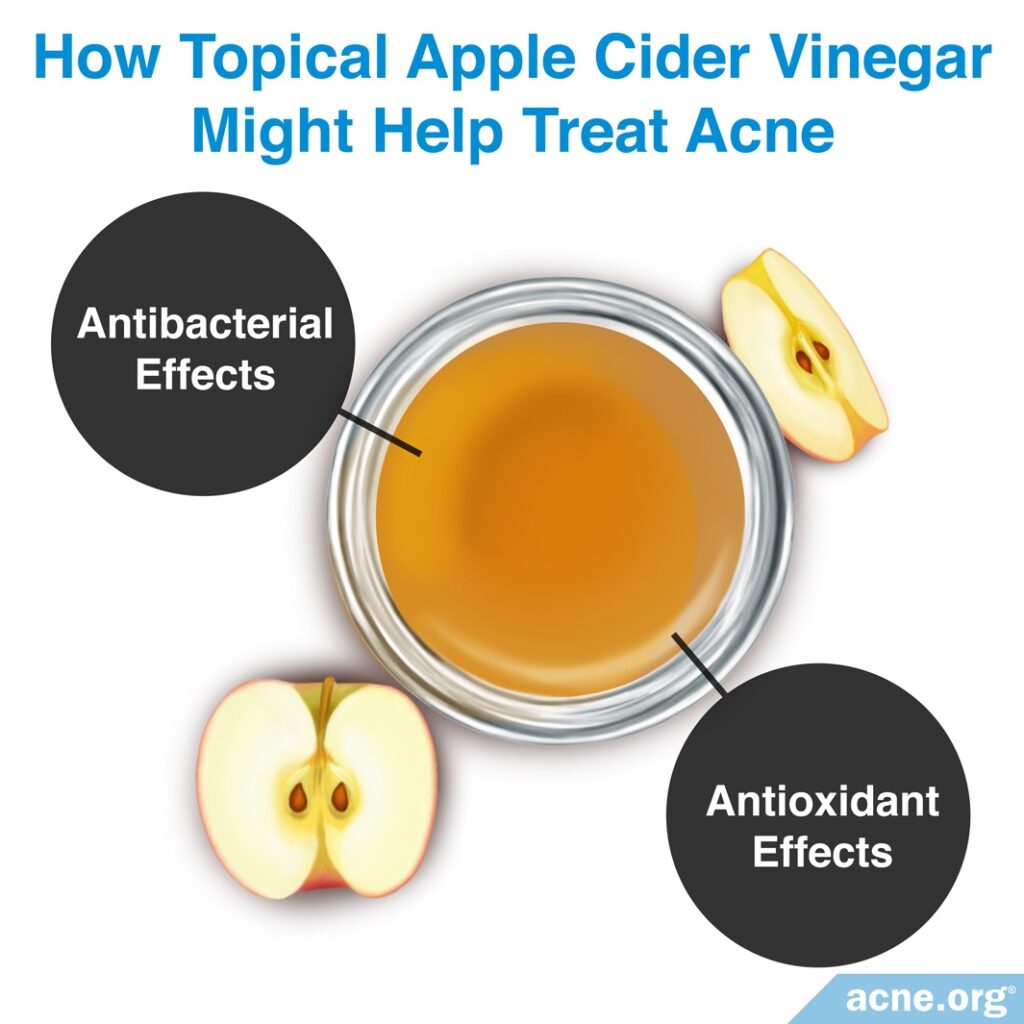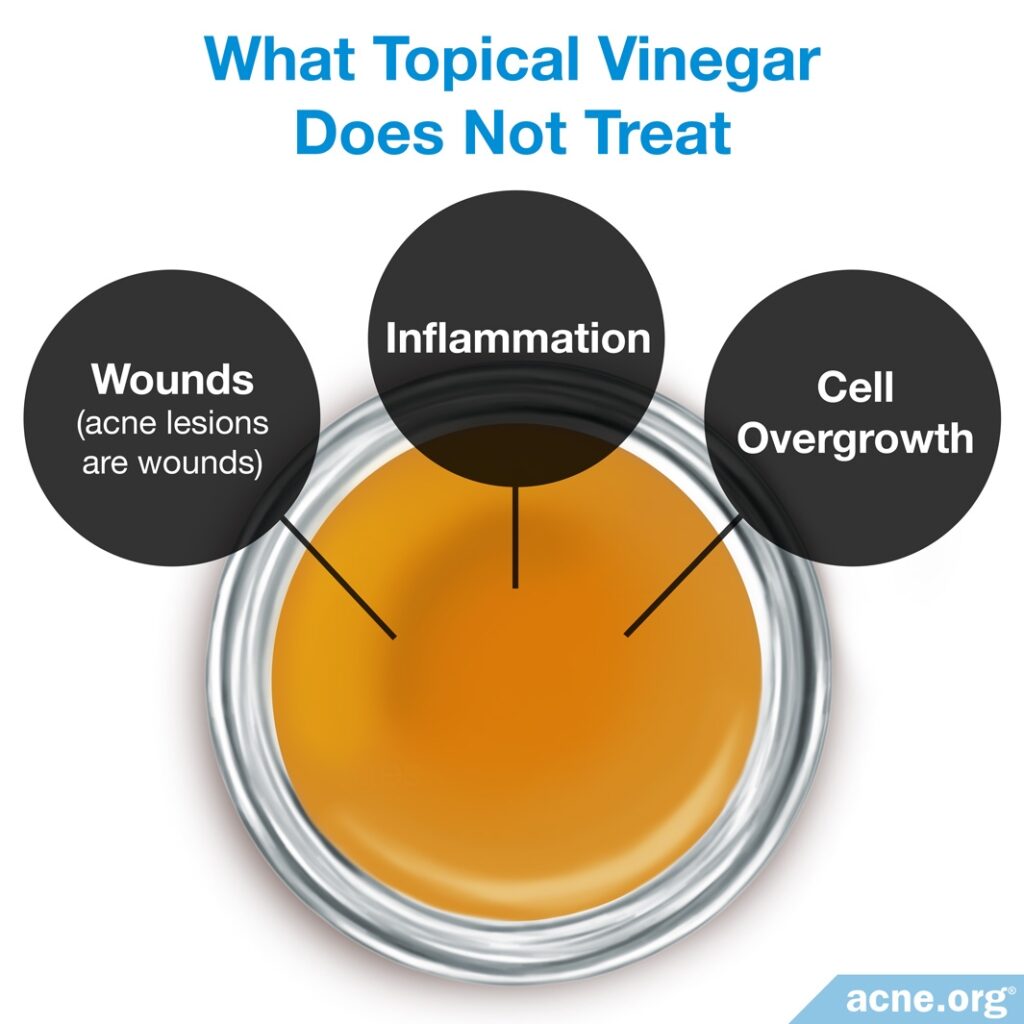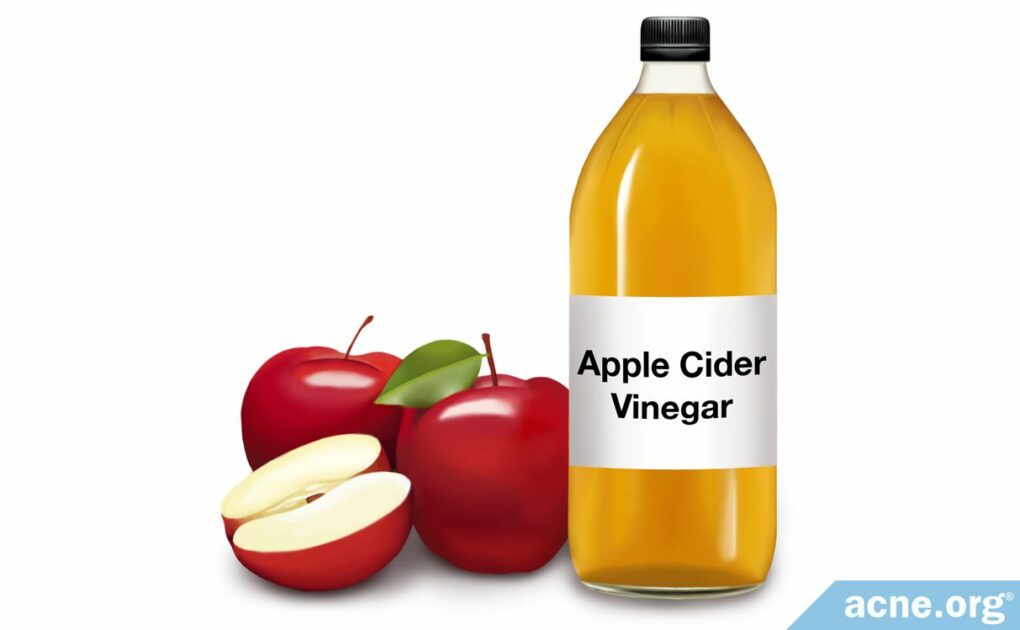Apple Cider Vinegar (ACV) May Have Some Antibacterial and Antioxidant Properties, but Don’t Expect Miracles

The Essential Info
While there is no research concerning topical apple cider vinegar as an acne treatment, people have been using topical vinegar medicinally for thousands of years because it comes with:
- Antibacterial Effects: The natural acidity of the active component of vinegar, acetic acid, has well-documented antibacterial effects against a wide range of bacteria, and acne is, at least in part, a bacterial disease. Given these antibacterial effects, vinegar might be at least somewhat helpful in acne treatment.
- Antioxidant Effects: Vinegar may also have antioxidant effects, which could hypothetically reduce the inflammation seen in acne.
However, it might also cause:
- Irritation: The acetic acid in vinegar might irritate wounds and potentially increase inflammation.
The Bottom Line: In the real world, anecdotal evidence shows us that applying apple cider vinegar to your skin might help clear up acne a bit, but is unlikely to dramatically reduce acne.

The Science
- Jump Down to How to Do It
- What Is Vinegar?
- How It Might Help Treat Acne
- What It Does Not Treat
- Side Effects of Topical Vinegar
Some people with acne use topical (applied to the skin) apple cider vinegar as a natural remedy in an attempt to control their acne. Anecdotal reports are mixed, and there are no studies concerning topical vinegar’s effects on acne, but there is scientific evidence indicating that vinegar has antibacterial properties and contains antioxidants, both of which might be helpful in treating acne.
However, there is no evidence that vinegar helps with other aspects of acne such as inflammation, wound healing, or cell overgrowth, and there is some concern that a compound in vinegar, called acetic acid, might increase inflammation in the skin.
To unravel this topic as much as we can, let’s start by looking at what vinegar is.
What Is Vinegar?
Vinegar is a natural food product that is made through a process called fermentation. Fermentation uses yeast and bacteria to convert sugar into alcohol or acids. Vinegar fermentation is a two-step process:
- In the first step, yeast converts sugar from a carbohydrate-containing food such as apples, grapes, or grains into alcohol.
- In the second step, a type of bacteria called Acetobacter turns the alcohol into acetic acid, which is the main component of vinegar.1-4
Fermentation of different foods results in different kinds of vinegar. For example, fermenting apple cider results in apple cider vinegar, fermenting wine results in wine vinegar, and fermenting berries results in berry vinegar.1,3,4
Interestingly, while most vinegar is produced commercially, anyone can make vinegar at home. According to a 1976 chapter in the book series Advances in Applied Microbiology, “Nearly any unfortified wine or beer when exposed to the atmosphere will develop an acidity which, in many cases, results from the action of Acetobacter in converting the ethanol to acetic acid. Under normal household conditions, the conversion occurs quite slowly and there are no sharp lines of demarcation between the categories of wine, old wine, sour wine, and vinegar.”2
Vinegar is mostly water and acetic acid, but it also contains a variety of other compounds in small amounts, including vitamins, mineral salts, amino acids (molecules that form the basis of proteins), various acids such as lactic, citric, and malic acids, and a group of compounds called flavonoids. These additional compounds give vinegar its characteristic flavor. Both acetic acid and flavonoids could also contribute to therapeutic effects on acne; we will discuss these effects later in this article.2,5
Expand to read how topical vinegar has been used in medicine
People have used apple cider vinegar medicinally for more than 5,000 years for a variety of ailments, including the following:
- In 400 B.C., Hippocrates, a Greek doctor who is considered to be the father of modern medicine, prescribed a mixture of honey and apple cider vinegar to cure diseases.2,3
- During the American Civil War in the 1860s, doctors used apple cider vinegar to disinfect soldiers’ wounds.3
- According to a 1976 chapter in the book series Advances in Applied Microbiology, apple cider vinegar has also been used in “[lotions] to treat lameness, poison ivy, shingles, night sweats, burns, varicose veins, impetigo, and ringworm.”2
How It Might Help Treat Acne

Antibacterial Effects
Acne is in part a bacterial disease. A specific type of bacteria called C. acnes has been implicated in leading to much of the redness and soreness that we see in and around acne lesions. Therefore, any substance that is effective against this bacteria might be beneficial in treating acne.
Vinegar has antibacterial effects, and in fact, people have been using it as an antibacterial agent for thousands of years, long before the discovery of antibiotics as we know them. According to a book series Advances in Applied Microbiology, “Possibly vinegar was the first antibiotic known to man, a bacterial product antagonistic to other microorganisms.”2
Past research has indicated that acetic acid, the main ingredient in vinegar, has broad-spectrum antibacterial activity against a variety of bacteria. Four studies published in medical journals confirm this finding.6-9 However, no studies have tested the ability of vinegar to kill C. acnes specifically.
Expand to read details of studies

A 2009 study in the journal Burns confirmed this. The authors of this study concluded, “The tests showed excellent bactericidal effect of acetic acid, particularly with problematic [g]ram-negative bacteria.”7

Similarly, a 2013 study in The Journal of Hospital Infection demonstrated that acetic acid at concentrations between 0.166% and 0.625% was effective against several antibiotic-resistant types of bacteria. The authors also found that, as an antiseptic (substance to prevent or treat infection), acetic acid performed at least as well as currently used antiseptic products.6

A 2018 study in the journal Scientific Reports showed that apple cider vinegar was effective at killing several types of bacteria, including Staphylococcus aureus and Escherichia coli.8

A 2021 study in the journal Scientific Reports found that apple cider vinegar can inhibit the growth of two types of antibiotic-resistant bacteria, methicillin-resistant Staphylococcus aureus (MRSA) and resistant Escherichia coli (rE. coli). The researchers wrote, “We conclude that ACV can have powerful anti-microbial effects directly on resistant E. coli and MRSA.”9
The antibacterial action of topically applied vinegar is related to its acidity (low pH), but some of the compounds present in vinegar may also contribute to its antibacterial action, as noted in a medical textbook.10
Expand to read quote from book

As a 2009 chapter in the book Complementary and Alternative Therapies in the Aging Population states, “The [antibacterial] properties of vinegar are well documented and relate directly to the pH-lowering effect of acetic acid; yet it is possible that some inhibitory compounds other than acetic acid may be present in vinegar.”10
As we can see, vinegar’s antibacterial properties are well known and are effective against a wide variety of bacteria. Whether these effects apply specifically to acne is undetermined, as no studies have looked at this, but vinegar may very well be effective against the bacteria present in acne.
Antioxidant Effects
Vinegar also contains several compounds, including flavonoids, that are antioxidants.11 Antioxidants are molecules that prevent cell damage from harmful molecules called free radicals.
This is important to acne because the damage from free radicals on the skin can result in inflammation and skin breakouts. Antioxidants might help treat acne by preventing free radicals from harming the skin.
Antioxidants also protect the skin by preventing external toxins from penetrating beyond the outermost layer of skin. A low amount of antioxidants near the skin hair follicles and skin oil glands has been implicated in acne development.
As noted in a recent scientific article, antioxidants in vinegar may help protect acne-prone skin from oxidative damage.12,13
Expand to read quotes from studies

According to a 2014 article in the Journal of Food Science, “Bioactive substances such as polyphenols [for example, flavonoids] and vitamins in different types of vinegar defend against oxidative stress due to their significant antioxidant activity.”12

Similarly, a 2021 study published in the Journal of Food Biochemistry showed that apple cider vinegar has high antioxidant potential. The study authors wrote, “Therefore, ACV could be characterized as a new pharmacological therapeutic agent that…provides antioxidant protection.”13
What It Does Not Treat

While vinegar has well-documented antibacterial and antioxidant properties, both of which might be at least somewhat effective for acne, there are several other aspects of acne that topical vinegar cannot treat and may actually aggravate.
Wound healing: Medically speaking, acne lesions are wounds. Proper wound healing is important in acne treatment, not only for clearing up the lesions themselves, but also for preventing scarring. Acetic acid does not have wound healing properties, and in fact, in concentrations of more than 10%, acetic acid can irritate wounds and cause inflammation.12,14 Most vinegar on store shelves contains 4-9% acetic acid.15
Inflammation: Acne is primarily an inflammatory condition. The only scientific evidence that vinegar has anti-inflammatory effects comes from one study. This study found that applying a vinegar-based cream to the skin of patients with atopic dermatitis (a type of inflammatory rash) had a beneficial effect.16 On the other hand, acetic acid at concentrations of more than 10% can actually cause inflammation.12 For example, one study found that soaking the skin in diluted apple cider vinegar actually caused skin irritation in the majority of patients with atopic dermatitis.17 These conflicting findings show that more research is necessary to determine just how much vinegar we need to use to gain the maximum benefits while minimizing side effects like skin irritation.
Cell overgrowth: Acne is caused in part by overgrowth of skin cells within pores. There is no evidence that vinegar can reduce this overgrowth in any way.
Side Effects of Topical Vinegar
Vinegar has been used topically for thousands of years, and no side effects have been reported in people using common topical vinegar. However, as mentioned above, more concentrated acetic acid can cause wounds and inflammation. A recent scientific article emphasizes that the acid concentrations found in vinegar are harmless, but higher concentrations of acetic acid can corrode the skin.12
Expand to read quote from study

A 2015 article in the journal Advances in Wound Care explains, “Acetic acid is considered harmless below concentrations of 5%, as in vinegar, but in concentrations between 10% and 30% acetic acid is corrosive.”12
Warning – never use glacial acetic acid: Acetic acid can be concentrated to form products with 100% acetic acid. This type of acetic acid is called glacial acetic acid, which is harmful to skin. Even when diluted, glacial acetic acid can cause burns when applied to the skin, and may cause scarring. Glacial acetic acid also causes skin damage that can result in absorbing the acid through the skin and into the body. If this happens, damage to organs like the kidneys and liver can occur.18
How to Do It:
If you would like to try adding apple cider vinegar (ACV) to your skin care regimen, follow these simple steps:
- Start with an organic, unfiltered apple cider vinegar.
- Always dilute the ACV with filtered/distilled water. In a small glass container, mix ACV with filtered water. Start with 1 tablespoon of ACV and mix with 2-3 tablespoons of water. (If you have sensitive skin, dilute the ACV further by using more water. You can try building up to using less-diluted ACV over time.)
- Cleanse your skin using your bare hands and a mild facial cleanser, and gently pat dry with a towel. Remember, physical irritation of the skin makes acne worse, so stay ultra-gentle.
- Soak a cotton ball or cotton pad with the ACV mixture and very gently apply to the skin. Don’t scrub. Stay exceedingly gentle.
- Wait until the ACV mixture has dried. You can now apply other products if you wish.
References
- Samad, A., Azlan, A. & Ismail, A. Therapeutic effects of vinegar: A review. Curr. Opin. Food Sci. 8, 56 – 61 (2016). https://www.sciencedirect.com/science/article/abs/pii/S2214799316300479
- Conner, H. A., & Allgeier, R. J. Vinegar: Its history and development. In: Advances in Applied Microbiology. 20, 81-133 (1976). https://www.sciencedirect.com/science/article/pii/S0065216408701102
- Atik, D., Atik, C. & Karatepe, C. The effect of external apple vinegar application on varicosity symptoms, pain, and social appearance anxiety: A randomized controlled trial. Evidence-based Complement. Altern. Med. (2016). https://www.hindawi.com/journals/ecam/2016/6473678/
- Dabija, A. & Hatnean, C. A. Study concerning the quality of apple vinegar obtained through classical method. J. Agroaliment. Process. Technol. 20, 304 – 310 (2014). https://pdfs.semanticscholar.org/7090/6c7a543fc810cf99a157184197ff252607b5.pdf
- Setorki, M., Asgary, S., Eidi, A., Rohani, A. H. & Khazaei, M. Acute effects of vinegar intake on some biochemical risk factors of atherosclerosis in hypercholesterolemic rabbits. Lipids Health Dis. 9, 10 (2010). https://www.ncbi.nlm.nih.gov/pubmed/20109192
- Fraise, A. P., Wilkinson, M. A. C., Bradley, C. R., Oppenheim, B. & Moiemen, N. The antibacterial activity and stability of acetic acid. J. Hosp. Infect. 84, 329 – 331 (2013). https://www.journalofhospitalinfection.com/article/S0195-6701(13)00184-9/abstract
- Johnston, C. S. Medicinal uses of vinegar. In: Complementary and Alternative Therapies in the Aging Population. p. 433-443 (2009). https://www.sciencedirect.com/book/9780123742285/complementary-and-alternative-therapies-and-the-aging-population
- Yagnik, D., Serafin, V. and J Shah, A. Antimicrobial activity of apple cider vinegar against Escherichia coli, Staphylococcus aureus and Candida albicans; downregulating cytokine and microbial protein expression. Sci. Rep. 8, 1732 (2018). https://www.ncbi.nlm.nih.gov/pubmed/29379012
- Yagnik, D., Ward, M. & Shah, A. J. Antibacterial apple cider vinegar eradicates methicillin resistant Staphylococcus aureus and resistant Escherichia coli. Sci. Rep. 11, 1854 (2021). https://pubmed.ncbi.nlm.nih.gov/33473148/
- Johnston, C. S. Medicinal uses of vinegar 1. Medscape Gen. Med. 8, 433 – 443 (2006). https://www.ncbi.nlm.nih.gov/pmc/articles/PMC1785201/
- Budak, N. H., Aykin, E., Seydim, A. C., Greene, A. K. & Guzel-Seydim, Z. B. Functional properties of vinegar. J. Food Sci. 79, R757-R764 (2014). https://www.ncbi.nlm.nih.gov/pubmed/24811350
- Bjarnsholt, T. et al. Antibiofilm Properties of Acetic Acid. Adv. Wound Care 4, 363 – 372 (2015). https://www.ncbi.nlm.nih.gov/pubmed/26155378
- Tripathi, S., Kumari, U. & Mitra Mazumder, P. Ameliorative effects of apple cider vinegar on neurological complications via regulation of oxidative stress markers. J. Food Biochem. 44, e13504 (2020). https://pubmed.ncbi.nlm.nih.gov/33084094/
- Canadian Agency for Drugs and Technologies in Health. Acetic Acid for Wound Care: Clinical Effectiveness and Guidelines. (2015). https://www.cadth.ca/acetic-acid-wound-care-clinical-effectiveness-and-guidelines
- Bunick, C., et al. Chemical burn from topical apple cider vinegar. J. Am. Acad. Dermatology 67, 143 – 144 (2010). https://www.ncbi.nlm.nih.gov/pubmed/22980269
- Lee, N. R., Lee, H. J., Yoon, N. Y., Kim, D., Jung, M. & Choi, E. H. Application of topical acids improves atopic dermatitis in murine model by enhancement of skin barrier functions regardless of the origin of acids. Ann. Dermatol. 28, 690 – 696 (2016). https://www.ncbi.nlm.nih.gov/pmc/articles/PMC5125949/
- Luu, L. A., Flowers, R. H., Kellams, A. L., et al. Apple cider vinegar soaks [0.5%] as a treatment for atopic dermatitis do not improve skin barrier integrity. Pediatr. Dermatol. 36, 634 – 639 (2019). https://www.ncbi.nlm.nih.gov/pubmed/31328306
- Yoo, J. H., Roh, S. G., Lee, N. H., Yang, K. M. & Moon, J. H. A case report of a chemical burn due to the misuse of glacial acetic acid. J. Plast. Reconstr. Aesthetic Surg. 63, 829 – 831 (2010). https://www.ncbi.nlm.nih.gov/pubmed/20708991
 Acne.org Products
Acne.org Products